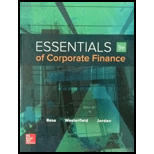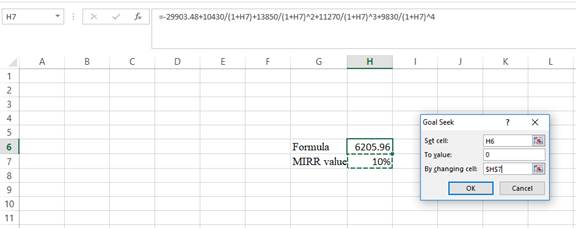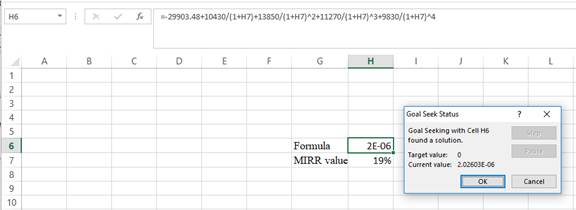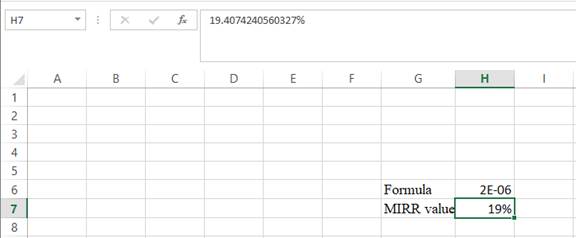
Concept explainers
MIRR. Suppose the company in the previous problem uses a discount rate of 11 percent and a reinvestment rate of 8 percent on all of its projects. Calculate the MIRR of the project using all three methods with these rates.
To calculate: The MIRR (Modified Internal Rate of Return) for the project utilizing all three methods at a rate of discount and rate of reinvestment of 11% and 8% respectively.
Introduction:
MIRR is the Modified Internal Rate of Return which is a financial measure of attracting the investments. It is utilized in capital budgeting to rank the alternative investments of the same size.
Answer to Problem 23QP
The MIRR for the project using the discounted approach is 19.41%, reinvestment approach is 13.30%, and combination approach is 13.12%.
Explanation of Solution
Given information:
Company M is assessing a project where the cash flows are $10,430, $13,850, $11,270, $9,830, and -$4,050 for year 1, 2, 3, 4, and 5 respectively. The initial cost is $27,500. The rate of discount and the rate of reinvestment are 11% and 8% respectively.
Discounted approach:
In this approach, compute the negative cash outflows value at year 0. On the other hand, the positive cash flows remain at its time of occurrence. Hence, discount the cash outflows to year 0.
Hence, the discounted cash flow at time 0 is -$29,903.48.
Equation of MIRR in discounted approach:
Compute MIRR using a spreadsheet:
Step 1:

- Type the equation of NPV in H6 in the spreadsheet and consider the MIRR value as H7.
Step 2:

- Assume the MIRR value as 10%.
Step 3:

- In the spreadsheet, go to data and select the what-if analysis.
- In the what-if analysis, select goal seek.
- In set cell, select H6 (the formula).
- The “To value” is considered as 0 (the assumption value for NPV).
- The H7 cell is selected for the by changing cell.
Step 4:

- Following the previous step click OK in the goal seek. The goal seek status appears with the MIRR value.
Step 5:

- Thevalue appears to be 19.4074240560327%.
Hence, the MIRR value is 19.41%.
Reinvestment approach:
In this approach, compute the future value of all the cash flows excluding the initial cost at the closure of the project. Hence, compute the reinvesting cash flows to year 5 is:
Hence, the reinvesting cash flow at time 5 is $51,348.64.
Equation of MIRR in reinvestment approach:
Compute the MIRR:
Hence, the MIRR is 13.30%.
Combination approach:
In this approach, compute all the cash outflows at year 0 and all the cash inflows at the closure of the project. Hence, the value of the cash flows is as follows:
Hence, the total cash outflow at year 0 is -$29,903.48.
Hence, the value of total cash inflows is $55,398.64.
Equation of MIRR in combination approach:
Compute the MIRR:
Hence, the MIRR is 13.12%.
Want to see more full solutions like this?
Chapter 8 Solutions
Essentials of Corporate Finance (Mcgraw-hill/Irwin Series in Finance, Insurance, and Real Estate)
- Revision Questions for This Week Suppose you see the following regression table: earnings Coef. Std. Err. married 7737.006 265.0139 _cons 9058.677 210.3906 1. What are the 95 confidence intervals for (i) the intercept, (ii). the slope, rounded to the second decimal place? 2. Are any of the coefficients statistically significant at the 5% level of significance? Explain. 3. Return to the t-statistic example from earlier (below). Do either of the 95% confidence intervals contain zero? Should they? log(wage) = .284.092 educ· (.104) (.007)arrow_forwardKenji’s Tax Scenario Kenji is a young professional with taxable income of $138,000 as an advertising account executive. What is Kenji’s total tax liability? (Note: Round your answer to the nearest cent, if necessary.) What is Kenji’s top marginal tax rate? What is Kenji's average tax rate?arrow_forward1. A project manager is using the payback method to make the final decision on which project to undertake. The company has a 9% required rate of return and expects a 5% rate of inflation for the following five years. i. ii. What is the non-discounted payback of a project that has cash flows as shown in the table? What is the rate of return? (use equation given in class) Cash Outflow Cash inflow Net Flow Year 10 $500,000 0 1 12. * 0 $75,000 & $50,000 $150,000 3 $200,000 $350,000 4 0 $150,000 5 0 $750,000arrow_forward
- Problem 4. Consider the following balance sheet for Watchover Savings Incorporated (in millions): Assets Liabilities and Equity Floating-rate mortgages (currently 12% per annum) Now deposits (currently 8% per $ 82 annum) $ 116 30-year fixed-rate loans (currently 9% per annum) 5-year time deposits (currently 8% per 101 annum) 29 Equity 38 $ 183 Total $ 183 Total a. What is Watchover's expected net interest income at year-end? b. What will be the net interest income at year-end if interest rates rise by 3 percent? c. Using the one-year cumulative repricing gap model, what is the change in the expected net interest income for a 3 percent increase in interest rates?arrow_forwardYou are given the following information for Frankenson Pizza Company: Sales = $72,000; Costs = $32,300; Addition to retained earnings = $6,500; Dividends paid = $2,220; Interest expense = $5,200; Tax rate = 23 percent. Calculate the depreciation expense. Note: Do not round intermediate calculations and round your answer to the nearest whole number, e.g., 32.arrow_forwardAssume coupons are paid annually. Here are the prices of three bonds with 10-year maturities. Assume face value is $100. Bond Coupon (%) Price (%) 2 4 8 81.62 98.39 133.42 a. What is the yield to maturity of each bond? b. What is the duration of each bond? Complete this question by entering your answers in the tabs below. Required A Required B What is the yield to maturity of each bond? Note: Do not round intermediate calculations. Enter your answers as a percent rounded to 2 decimal places. Bond Coupon (%) YTM 2 % 4 8 % % Required A Required R Required B What is the duration of each bond? Note: Do not round intermediate calculations. Round your answers to 2 decimal places. Bond Coupon (%) Duration 2 years 4 years 8 yearsarrow_forward
- Two building owners - Alice and Bob - each own a building worth $1,000,000. They are considering forming a mutual insurance pool. Based on historical data, there are three possible fire damage scenarios for each building in a given year: No damage: 85% probability Partial damage: 12% probability, with repair costs of $200,000 Total loss: 3% probability, with a cost of $1,000,000 Calculate the standard deviation of the loss of each owner with pooling (2 buildings together)arrow_forwardCritically evaluate the usefulness of Net Present Value as an investment appraisal.arrow_forwardSales are $2.90 million, cost of goods sold is $590,000, depreciation expense is $148,000, other operating expenses are $298,000, addition to retained earnings is $1,126,625, dividends per share are $1, tax rate is 21 percent, and number of shares of common stock outstanding is 88,000. LaTonya's Flop Shops has no preferred stock outstanding. Use the above information to calculate the times interest earned ratio for LaTonya's Flop Shops, Incorporated. Note: Round your answer to 2 decimal places. Interest earned timesarrow_forward
- Two building owners - Alice and Bob - each own a building worth $1,000,000. They are considering forming a mutual insurance pool. Based on historical data, there are three possible fire damage scenarios for each building in a given year: No damage: 85% probability Partial damage: 12% probability, with repair costs of $200,000 Total loss: 3% probability, with a cost of $1,000,000 Calculate the standard deviationarrow_forwardWhat is the role of the researcher, population and sampling, and data collection, could you help explain each one of them? How to start working on the population structures essential to research? What are the structured ways in which to present key research elements?arrow_forwardCould you please help explain the Qualitative Research Data Analysis? What is the Coding, and Interrater Reliability? How do they work and when we use them?What are the description of populations and Samples, please help to explain them.arrow_forward
 EBK CONTEMPORARY FINANCIAL MANAGEMENTFinanceISBN:9781337514835Author:MOYERPublisher:CENGAGE LEARNING - CONSIGNMENT
EBK CONTEMPORARY FINANCIAL MANAGEMENTFinanceISBN:9781337514835Author:MOYERPublisher:CENGAGE LEARNING - CONSIGNMENT
